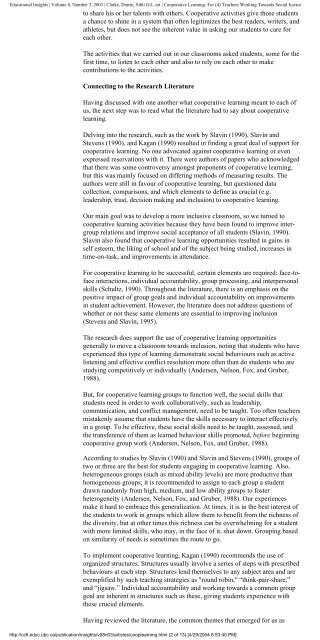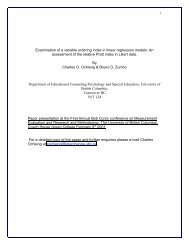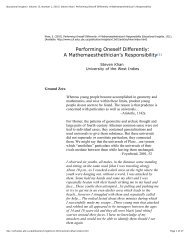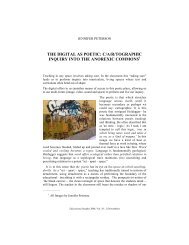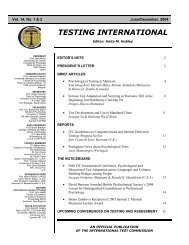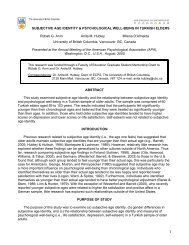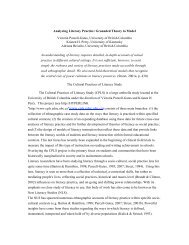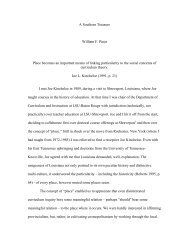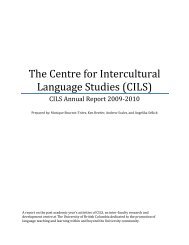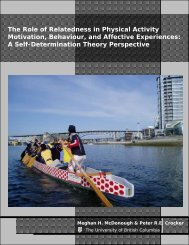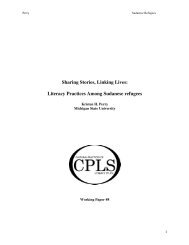Educational Insights | Volume 8, Number 3, 2003 | Clarke, Darrin ...
Educational Insights | Volume 8, Number 3, 2003 | Clarke, Darrin ...
Educational Insights | Volume 8, Number 3, 2003 | Clarke, Darrin ...
Create successful ePaper yourself
Turn your PDF publications into a flip-book with our unique Google optimized e-Paper software.
<strong>Educational</strong> <strong>Insights</strong> | <strong>Volume</strong> 8, <strong>Number</strong> 3, <strong>2003</strong> | <strong>Clarke</strong>, <strong>Darrin</strong>, Sibli Gil...art | Cooperative Learning: For (4) Teachers Working Towards Social Justice<br />
to share his or her talents with others. Cooperative activities give those students<br />
a chance to shine in a system that often legitimizes the best readers, writers, and<br />
athletes, but does not see the inherent value in asking our students to care for<br />
each other.<br />
The activities that we carried out in our classrooms asked students, some for the<br />
first time, to listen to each other and also to rely on each other to make<br />
contributions to the activities.<br />
Connecting to the Research Literature<br />
Having discussed with one another what cooperative learning meant to each of<br />
us, the next step was to read what the literature had to say about cooperative<br />
learning.<br />
Delving into the research, such as the work by Slavin (1990), Slavin and<br />
Stevens (1990), and Kagan (1990) resulted in finding a great deal of support for<br />
cooperative learning. No one advocated against cooperative learning or even<br />
expressed reservations with it. There were authors of papers who acknowledged<br />
that there was some controversy amongst proponents of cooperative learning,<br />
but this was mainly focused on differing methods of measuring results. The<br />
authors were still in favour of cooperative learning, but questioned data<br />
collection, comparisons, and which elements to define as crucial (e.g.<br />
leadership, trust, decision making and inclusion) to cooperative learning.<br />
Our main goal was to develop a more inclusive classroom, so we turned to<br />
cooperative learning activities because they have been found to improve intergroup<br />
relations and improve social acceptance of all students (Slavin, 1990).<br />
Slavin also found that cooperative learning opportunities resulted in gains in<br />
self esteem, the liking of school and of the subject being studied, increases in<br />
time-on-task, and improvements in attendance.<br />
For cooperative learning to be successful, certain elements are required: face-toface<br />
interactions, individual accountability, group processing, and interpersonal<br />
skills (Schultz, 1990). Throughout the literature, there is an emphasis on the<br />
positive impact of group goals and individual accountability on improvements<br />
in student achievement. However, the literature does not address questions of<br />
whether or not these same elements are essential to improving inclusion<br />
(Stevens and Slavin, 1995).<br />
The research does support the use of cooperative learning opportunities<br />
generally to move a classroom towards inclusion, noting that students who have<br />
experienced this type of learning demonstrate social behaviours such as active<br />
listening and effective conflict resolution more often than do students who are<br />
studying competitively or individually (Andersen, Nelson, Fox, and Gruber,<br />
1988).<br />
But, for cooperative learning groups to function well, the social skills that<br />
students need in order to work collaboratively, such as leadership,<br />
communication, and conflict management, need to be taught. Too often teachers<br />
mistakenly assume that students have the skills necessary to interact effectively<br />
in a group. To be effective, these social skills need to be taught, assessed, and<br />
the transference of them as learned behaviour skills promoted, before beginning<br />
cooperative group work (Andersen, Nelson, Fox, and Gruber, 1988).<br />
According to studies by Slavin (1990) and Slavin and Stevens (1990), groups of<br />
two or three are the best for students engaging in cooperative learning. Also,<br />
heterogeneous groups (such as mixed ability levels) are more productive than<br />
homogeneous groups; it is recommended to assign to each group a student<br />
drawn randomly from high, medium, and low ability groups to foster<br />
heterogeneity (Andersen, Nelson, Fox, and Gruber, 1988). Our experiences<br />
make it hard to embrace this generalization. At times, it is in the best interest of<br />
the students to work in groups which allow them to benefit from the richness of<br />
the diversity, but at other times this richness can be overwhelming for a student<br />
with more limited skills, who may, in the face of it, shut down. Grouping based<br />
on similarity of needs is sometimes the route to go.<br />
To implement cooperative learning, Kagan (1990) recommends the use of<br />
organized structures. Structures usually involve a series of steps with prescribed<br />
behaviours at each step. Structures lend themselves to any subject area and are<br />
exemplified by such teaching strategies as "round robin," “think-pair-share,”<br />
and “jigsaw.” Individual accountability and working towards a common group<br />
goal are inherent in structures such as these, giving students experience with<br />
these crucial elements.<br />
Having reviewed the literature, the common themes that emerged for us as<br />
http://ccfi.educ.ubc.ca/publication/insights/v08n03/articles/cooplearning.html (2 of 13) [4/29/2004 8:53:40 PM]


